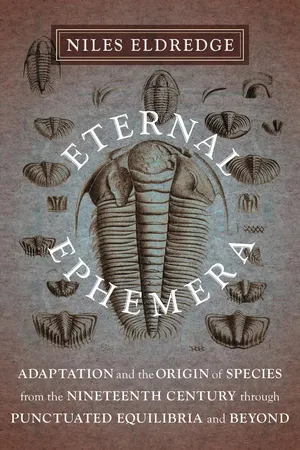Biological Sciences
Darwins Finches
Darwin's finches refer to a group of 15 species of small passerine birds found in the Galápagos Islands. They played a crucial role in Charles Darwin's theory of evolution by natural selection. The variations in beak shape and size among the finches helped Darwin understand how species could adapt to different environments, leading to his groundbreaking ideas on evolution.
Written by Perlego with AI-assistance
Related key terms
2 Key excerpts on "Darwins Finches"
- eBook - ePub
Evolution
What the Fossils Say and Why It Matters
- Donald R. Prothero, Carl Buell(Authors)
- 2017(Publication Date)
- Columbia University Press(Publisher)
It was not until he got back to England that ornithologist John Gould (recruited to study Darwin’s specimens) pointed this out to him. In the twentieth century, David Lack did a much more detailed study published in 1947. In recent years, Darwin’s finches have been the focus of research of Peter and Rosemary Grant of Princeton University. The Grants visited the islands year after year, documenting the changes in the finch populations. On one island (Daphne Major), the finch population changed dramatically from year to year. During a 1977 drought, the finches with strong beaks survived, because they could crack the toughest seeds and survive the shortage of food. The next few years, all of the finches on that island were their descendants and had the stronger nut-cracking bills found on other species of Galapagos finches. Since that time, the return of wetter conditions has changed the finches yet again, so forms that have more normal beaks for eating a wide variety of seeds could also survive. From this, it is easy to see how such strong selection pressures could transform the ancestral finches (which still live in South America) into a wide variety of specialized finches that perform the roles that other birds play on the mainland. Instead of nuthatches, there are thick-billed finches; instead of woodpeckers, there are finches with long bills for drilling wood and probing for grubs; instead of warblers, there are finches with similar bills called warbler finches - eBook - ePub
Eternal Ephemera
Adaptation and the Origin of Species from the Nineteenth Century Through Punctuated Equilibria and Beyond
- Niles Eldredge(Author)
- 2015(Publication Date)
- Columbia University Press(Publisher)
chapter 4 , ever since Dobzhansky and Mayr, such anatomical divergence is generally considered to be adaptive and effected by natural selection. Lacking a fully satisfactory theory of how adaptation occurs, and thus perforce considering the processes underlying adaptation to be a “black box” at the time he was writing Notebook B, nonetheless Darwin’s version of geographic speciation, with the dual recognition of the importance of isolation, and the as-yet not fully explained “black box” process of adaptation to new circumstances, is equally law-like.Easiest to see, of course, is the effect of pronounced, unarguable isolation, especially on islands separated by a goodly distance from the mainland, and in islands in archipelagos, separated one from another: “According to this view animals, on separate islands, ought to become different if kept long enough—<<apart, with slightly different circumstances.—>> Now Galapagos Tortoises, Mocking birds; Falkland Fox—Chiloe, fox,—Inglish & Irish Hare” (Darwin 1837–1839:7).Darwin is using his direct observations in South America, observations that led to the recognition of patterns of replacement of allied species, to frame this nearly full statement of geographic speciation. Only the “Inglish and Irish Hare” pairing forms an additional example (this one gleaned from the literature), a beginning of Darwin’s nascent tendency to choose the data and insights of others over his own field observations.And Darwin found it also easy to imagine how this might happen as a sort of “Gedanken experiment”: “Ægyptian cats & dogs ibis same as formerly but separate a pair & place them on fresh isld. it is very doubtful whether they would remain constant” (6). Here, once again, is the sacred Ibis, acknowledged as not having changed over the relatively brief interval between the Old Kingdom and modern times, but now speculatively linked to the process of geographic isolation and adaptation to the conditions of a “fresh island.”
Learn about this page
Index pages curate the most relevant extracts from our library of academic textbooks. They’ve been created using an in-house natural language model (NLM), each adding context and meaning to key research topics.

